book4_unit3__V-ing做表语_定语_宾语补足语_语法答案
- 格式:docx
- 大小:23.25 KB
- 文档页数:4
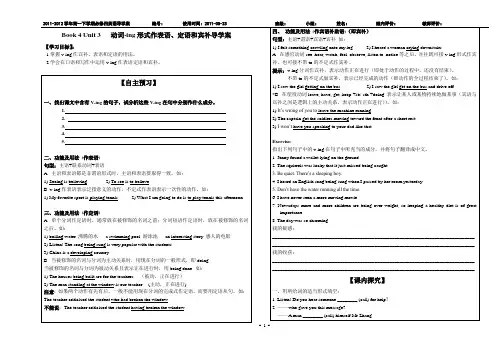
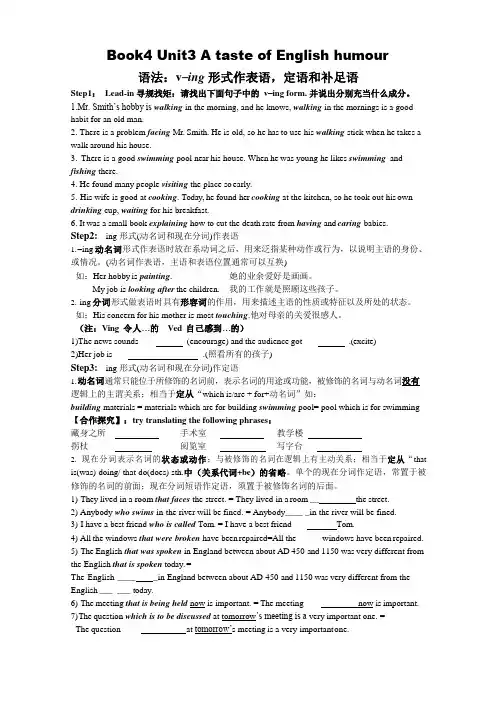
Book4 Unit3 A taste of English humour语法:v–ing 形式作表语,定语和补足语Step1:Lead-in 寻规找矩:请找出下面句子中的v–ing form. 并说出分别充当什么成分。
1.Mr. Smith’s hobby is walking in the morning, and he knows, walking in the mornings is a good habit for an old man.2.There is a problem facing Mr. Smith. He is old, so he has to use his walking stick when he takes a walk around his house.3.There is a good swimming pool near his house. When he was young he likes swimming and fishing there.4.He found many people visiting the place so early.5.His wife is good at cooking. Today, he found her cooking at the kitchen, so he took out his own drinking cup, waiting for his breakfast.6.It was a small book explaining how to cut the death rate from having and caring babies.Step2: ing 形式(动名词和现在分词)作表语1.–ing 动名词形式作表语时放在系动词之后,用来泛指某种动作或行为,以说明主语的身份、或情况。
(动名词作表语,主语和表语位置通常可以互换)如:Her hobby is painting. 她的业余爱好是画画。
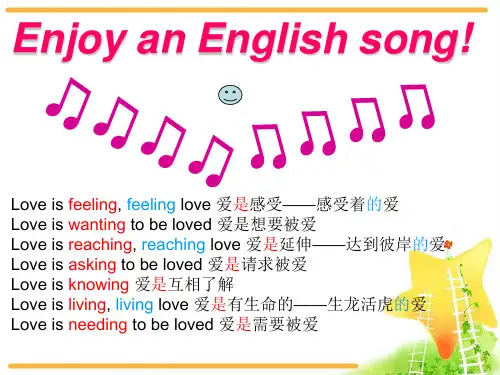
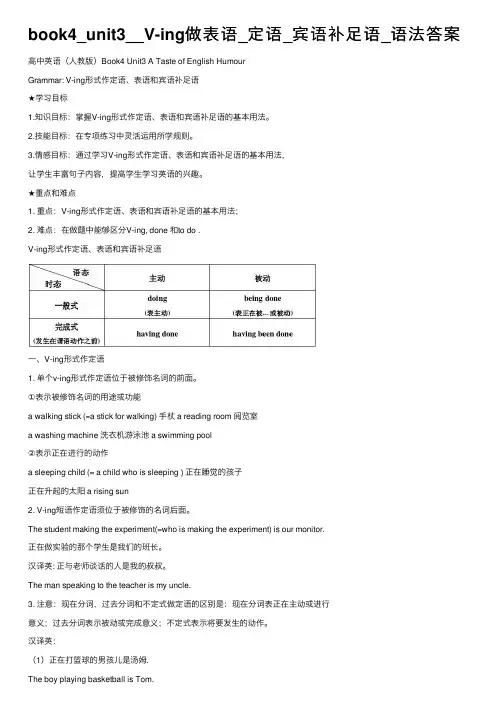
book4_unit3__V-ing做表语_定语_宾语补⾜语_语法答案⾼中英语(⼈教版)Book4 Unit3 A Taste of English HumourGrammar: V-ing形式作定语、表语和宾语补⾜语★学习⽬标1.知识⽬标:掌握V-ing形式作定语、表语和宾语补⾜语的基本⽤法。
2.技能⽬标:在专项练习中灵活运⽤所学规则。
3.情感⽬标:通过学习V-ing形式作定语、表语和宾语补⾜语的基本⽤法,让学⽣丰富句⼦内容,提⾼学⽣学习英语的兴趣。
★重点和难点1. 重点:V-ing形式作定语、表语和宾语补⾜语的基本⽤法;2. 难点:在做题中能够区分V-ing, done 和to do .V-ing形式作定语、表语和宾语补⾜语⼀、V-ing形式作定语1. 单个v-ing形式作定语位于被修饰名词的前⾯。
①表⽰被修饰名词的⽤途或功能a walking stick (=a stick for walking) ⼿杖 a reading room 阅览室a washing machine 洗⾐机游泳池 a swimming pool②表⽰正在进⾏的动作a sleeping child (= a child who is sleeping ) 正在睡觉的孩⼦正在升起的太阳 a rising sun2. V-ing短语作定语须位于被修饰的名词后⾯。
The student making the experiment(=who is making the experiment) is our monitor.正在做实验的那个学⽣是我们的班长。
汉译英: 正与⽼师谈话的⼈是我的叔叔。
The man speaking to the teacher is my uncle.3. 注意:现在分词,过去分词和不定式做定语的区别是:现在分词表正在主动或进⾏意义;过去分词表⽰被动或完成意义;不定式表⽰将要发⽣的动作。
汉译英:(2)⽤过的书used books ⼀颗倒下的树 a fallen tree(3)我很多⼯作要做。
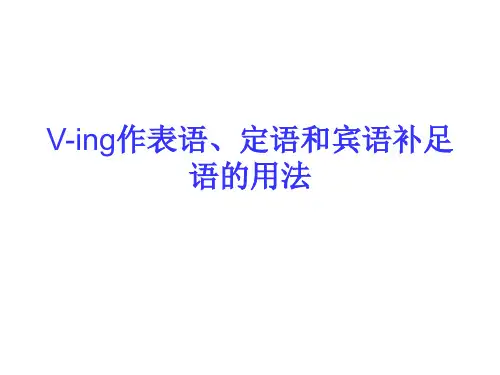
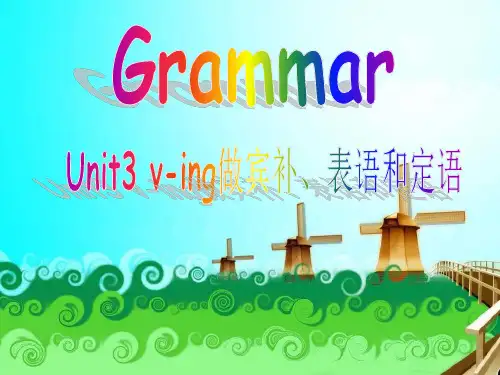
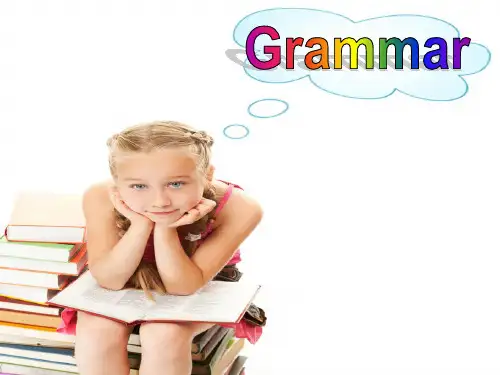
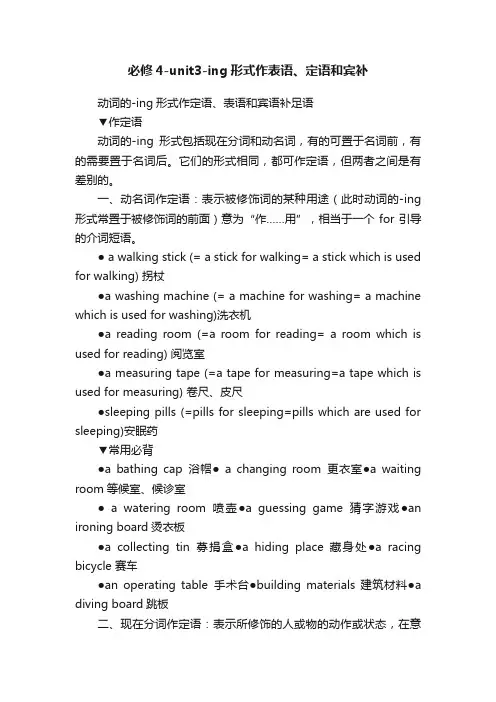
必修4-unit3-ing形式作表语、定语和宾补动词的-ing形式作定语、表语和宾语补足语▼作定语动词的-ing形式包括现在分词和动名词,有的可置于名词前,有的需要置于名词后。
它们的形式相同,都可作定语,但两者之间是有差别的。
一、动名词作定语:表示被修饰词的某种用途(此时动词的-ing 形式常置于被修饰词的前面)意为“作……用”,相当于一个for引导的介词短语。
● a walking stick (= a stick for walking= a stick which is used for walking) 拐杖●a washing machine (= a machine for washing= a machine which is used for washing)洗衣机●a reading room (=a room for reading= a room which is used for reading) 阅览室●a measuring t ape (=a tape for measuring=a tape which is used for measuring) 卷尺、皮尺●sleeping pills (=pills for sleeping=pills which are used for sleeping)安眠药▼常用必背●a bathing cap浴帽● a changing room更衣室●a waiting room等候室、候诊室● a watering room喷壶●a guessing game猜字游戏●an ironing board烫衣板●a collecting tin募捐盒●a hiding place 藏身处●a racing bicycle 赛车●an operating table手术台●building materials 建筑材料●a diving board跳板二、现在分词作定语:表示所修饰的人或物的动作或状态,在意思上接近于一个定语从句,可以表示正在进行的动作,也可表示经常性的动作或当时的状态。
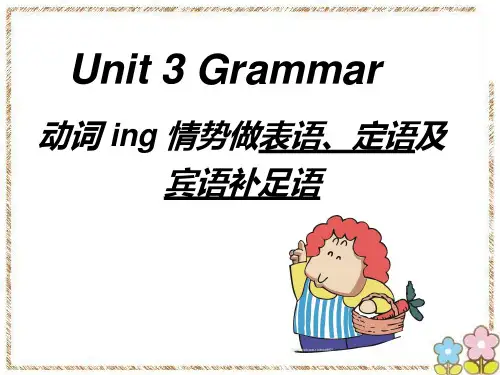
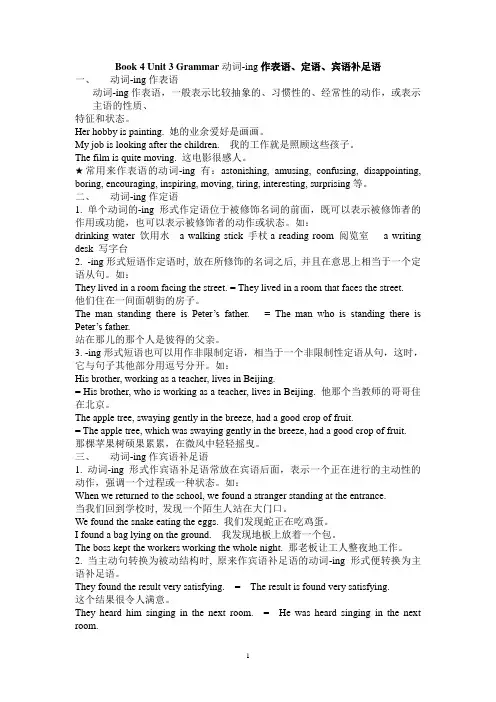
Book 4 Unit 3 Grammar动词-ing作表语、定语、宾语补足语一、动词-ing作表语动词-ing作表语,一般表示比较抽象的、习惯性的、经常性的动作,或表示主语的性质、特征和状态。
Her hobby is painting. 她的业余爱好是画画。
My job is looking after the children. 我的工作就是照顾这些孩子。
The film is quite moving. 这电影很感人。
★常用来作表语的动词-ing有:astonishing, amusing, confusing, disappointing, boring, encouraging, inspiring, moving, tiring, interesting, surprising等。
二、动词-ing作定语1. 单个动词的-ing形式作定语位于被修饰名词的前面,既可以表示被修饰者的作用或功能,也可以表示被修饰者的动作或状态。
如:drinking water 饮用水 a walking stick 手杖a reading room 阅览室 a writing desk 写字台2. -ing形式短语作定语时, 放在所修饰的名词之后, 并且在意思上相当于一个定语从句。
如:They lived in a room facing the street. = They lived in a room that faces the street.他们住在一间面朝街的房子。
The man standing there is Peter’s father. = The man who is standing there is Peter’s father.站在那儿的那个人是彼得的父亲。
3. -ing形式短语也可以用作非限制定语,相当于一个非限制性定语从句,这时,它与句子其他部分用逗号分开。
如:His brother, working as a teacher, lives in Beijing.= His brother, who is working as a teacher, lives in Beijing. 他那个当教师的哥哥住在北京。
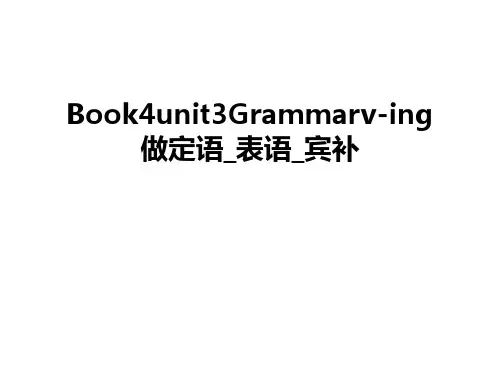
动词v-ing形式的基本概念1. 动词-ing形式的构成: 是在动词末尾加-ing 形式构成, 因此又叫动词的 -ing 形式。
如: do-doing, be-being, ask-asking, etc.否定形式: not+ -ing 构成2. 动词-ing形式不能单独作谓语, 没有人称和数的变化, 但可以有自己的宾语和状语, 还有时态和语态的变化。
3. 动词-ing形式由动词加-ing变化而成, 它同时具有名词和动词的特征, 在句中可以作主语、宾语等。
Doing Not doingBeing done Not being done Having done Not having done Having been done Not having been doneBook4 Unit2 动词-ing形式作主语和宾语I. 动词v-ing形式做主语1. 动词v-ing形式可直接置于句首作主语。
表示经常的、习惯性的动作或状态, 谓语动词通常用单数。
如:①Walking is a good form of exercise for both young and old.②Watching news on TV has become aroutine(日常习惯) for me.③Learning about a language is easier than using it.2. 为了保持句子平衡,通常用先行词it作形式主语,而把真正的主语放在句末,可以作表语的只能是某些形容词或少数名词,如useful,useless, good, fun, no use, worthwhile等①It is no use crying over spilt milk.作无益的后悔是没有用的。
②It is useless trying to argue(争辩) with Shylock(夏洛克,人名).③It’s fun jumping into cool water in hot summer.④It’s good using your head often.3. 动词-ing形式作主语的常用it作形式主语的句型有:①It +be +a waste(浪费) of time doing 做……是浪费时间的②It is/was no good/use doing 做……是没用处的③It is/was worth/worthwhile doing 做……是值得的④There is/was no point(意义) doing干…无意义⑤There is no sense in doing 做…没有道理⑥It is/was hardly/scarcely worth doing 做……不值得There is no doing 无法……; 不允许……There is/was no use doing 干…无意义There is/was nothing worse than doing 没有比…更糟的e.g.①There was no knowing where we would go. 我们不知道要去哪儿。
动词-ing形式作表语、定语和宾语补足语的练习一、用所给动词的适当形式填空。
1. We heaard them (quarrel) about money after the concert. They looked very angry.2. The villagers saw the fire (burn) brightly in the distance. When they hurried there,they found some houses (burn) to the ground already.3. I didn’t see anyone (take) away your paper. It might have been blown by thewind.4. During the days (come) we’ll make good preparations for the sports meeting.5. The woman (look) at her map is a relative of my mother.6. Einstein was one of the greatest scientists (repect) by people.7. Doing nothing is (do) ill.8. To do that would be (cut) the foot to fit the shoe.9. We were all very (surprise) at the news. I found it very(surprise).10. He gave us an (inspire) speech. We were all (inspire).二、在空白处填入适当的单词,完成下列句型转换(每空一词)。
1. Your task is cleaning the house carefully.______ ______ _______ _______ is your task.2. His speech inspired us. We _________ _________ by his speech.3. The boy who was missing was last seen playing near the lake. The ______ boy was last seen playingnear the lake.4. We heard that they were quarrelling about money after the concert. We heard ______ ______ about money after the concert.5. He made up his mind to buy a machine for washing for his parents. He made up his mind to buy a ______ ______ for his parents.6. The man who is talking to the teacher is a model worker. The man ______ ______ the teacheris a model worker.三、下列句子中各有一处错误,请指出并改正。
动词-ing形式作表语、定语和宾语补足语的练习一、用所给动词的适当形式填空。
1. We heaard them (quarrel) about money after the concert. They looked very angry.2. The villagers saw the fire (burn) brightly in the distance. When they hurried there,they found some houses (burn) to the ground already.3. I didn’t see anyone (take) away your paper. It might have been blown by thewind.4. During the days (come) we’ll make good preparations for the sports meeting.5. The woman (look) at her map is a relative of my mother.6. Einstein was one of the greatest scientists (repect) by people.7. Doing nothing is (do) ill.8. To do that would be (cut) the foot to fit the shoe.9. We were all very (surprise) at the news. I found it very(surprise).10. He gave us an (inspire) speech. We were all (inspire).二、在空白处填入适当的单词,完成下列句型转换(每空一词)。
1. Your task is cleaning the house carefully.______ ______ _______ _______ is your task.2. His speech inspired us. We _________ _________ by his speech.3. The boy who was missing was last seen playing near the lake. The ______ boy was last seen playingnear the lake.4. We heard that they were quarrelling about money after the concert. We heard ______ ______ about money after the concert.5. He made up his mind to buy a machine for washing for his parents. He made up his mind to buy a ______ ______ for his parents.6. The man who is talking to the teacher is a model worker. The man ______ ______ the teacheris a model worker.三、下列句子中各有一处错误,请指出并改正。
高中英语(人教版)Book4 Unit3 A Taste of English HumourGrammar: V-ing 形式作定语、表语和宾语补足语★学习目标1■知识目标:掌握V-ing形式作定语、表语和宾语补足语的基本用法。
2.技能目标:在专项练习中灵活运用所学规则。
3.情感目标:通过学习V-ing形式作定语、表语和宾语补足语的基本用法,让学生丰富句子内容,提高学生学习英语的兴趣。
★重点和难点1.重点:V-ing形式作定语、表语和宾语补足语的基本用法;2.难点:在做题中能够区分V-ing, done和to do .V-ing形式作定语、表语和宾语补足语探'、V-ing形式作定语1.单个v-ing形式作定语位于被修饰名词的前面。
①表示被修饰名词的用途或功能a walking stick (=a stick for walking) 手杖 a reading room 阅览室a washing machine 洗衣机游泳池 a swimming pool②表示正在进行的动作a slee ping child (= a child who is slee ping )正在睡觉的孩子正在升起的太阳a rising sun2. V-ing短语作定语须位于被修饰的名词后面。
The student making the £xperiment(=wboJs makingthe exp eriment) is our monitor. 正在做实验的那个学生是我们的班长。
汉译英:正与老师谈话的人是我的叔叔。
The man sp eaking to the teacher is my uncle3.注意:现在分词,过去分词和不定式做定语的区别是:现在分词表正在主动或进行意义;过去分词表示被动或完成意义;不定式表示将要发生的动作。
3.作表语的V-ing 形式也可带有自己的逻辑主语。
V-ing 形式作表语时,其逻辑主语往往是句子中的主语,但作表语的-ing 形式也可带有自己的逻辑主语,逻辑主语一般由形容词性物主代词或名词所有格来承担。
(1)What worries me most is her (Julia's) staying too late every night.我担心的是她天天晚上熬夜熬得太迟。
(staying too late every night 的逻辑主语是 Julia )(2)The main problem is your not having practiced a lot.主要的问题是你缺乏大量的练习。
(not having practiced a lot 的逻辑主语是you )三、V-ing 形式作宾语补足语1. V-ing 形式作宾语补足语常放在宾语后面,对宾语进行解释说明,表示一个正在进 行的主动性的动作,强调一个过程或一种状态。
其中,宾语和宾语补足语在逻辑 上有主动关系。
例: When we returned, we found a stranger standing in front of the house.a stranger 是 found 的宾语,standing in front of the house -是宾语补足语。
2.能用V-ing 形式作宾语补足语的常见的几类动词:⑴ 表示感觉和心理状态的动词:(see, watch, notice, hear, feel, smell, look at, listen to,observe, find )等动词 + sb. / sth. + doing sth.其中 doing sth.做宾补。
汉译英:汉译英:(1) 正在打篮球的男孩儿是汤姆The boy playing basketball is Tom.用过的书 used books 一颗倒下的树a fallen tree我很多工作要做。
I have a lot of work to do.(3) 【考例】 There were some boys D near the window, so I couldn't fall asleep.A. to shoutB. shoutedC. shout、V-ing 形式作表语1.当表示主语的内容时,表语与主语可调换位置。
D. shoutingMy favorite sport is swimming. = Swimming is my favorite sport. 汉译英:我的工作就是照顾这些孩子。
My job is looking after the children.2.当表示主语具有的特征、性质和状态(V-ing可调换位置。
相当一个形容词)时,表语与主语不这个问题很令人困惑。
The p roblem is quitepuzzling / confusing.C. interesting; tiringD. interested; tired我们听到隔壁一个女孩在唱歌。
We heard a girl singing in the next room.他看见孩子们在院子里玩。
He saw the children playing in the yard.(2)使役动词(常见的有 have, keep, get, leave, set, catch 等)+sb/ sth + doing sth (作 宾补)6. There are lots of pl aces of interest D in our city.8. As is known to us all, traveling is A , but we often feel ________________ when we are back fromtravels.A. interesting; tiredB. interested; tiring汉译英:我们让火整夜燃烧着。
We kept the fire burning all night long. 我很溃憾让你一直等着。
(3) see, watch, notice, hear, finddoing 表示动作正在进行,而 汉译英:I ' m sorry to havbeft you waiting.等后跟doing 与do 的区别:do 表示(或强调)动作从开始到结束的全过程。
你听见有人在敲门吗? 你听见有人敲门了吗?四、语法专练Do you hear someone knocking at the door ? Do you hear someone knock at the door?1. Tell Mary that there A. waitingB. waitedC. waits's someone for her at the door.D. to wait2. The A waiter came up to us and said, A. smilingB. smiledC. smile"You are welcome. ” D. to smile3. On festivals, the traffic p olice worked hard to kee p the traffic B smoothly.A. runB. runningC. to runD. being run4. Do you know the boy Dunder the big tree?B. lainA. lay5. I can hardly imagine P eterC. layingD. lying C across the Atlantic Ocean in five days.A. sailB. to sailC. sailingD. to have sailedA. needs rep airingB. needing rep airedC. needed rep airingD. needing to be rep aired7. There were some boys D near the window, so I couldn 'fall asleep. C. shoutA. to shoutB. shouted D. shouting9. To learn English well, we should find oppo rtunities to hear English C as much as we can. A. speak B. sp eaking C. sp oke D. to sp eak 10. As the stone was too heavy to move, I left it C on the ground. A. laying B. lay C. lying D. lain 11. John s bad habit is D without thorough understanding. A. read B. being read C. to be readD. reading12. The next morning she found the man A in bed, dead. A. lying B. lie C. lay D. laying13. Peopl e D in the city do not know the pl easure of country life. A. live B. to live C. lived 14. When he awoke, he found himself C by an old A. looked after B. be looked after C. being looked after D. be looking after 15. Sitting by her side, I could feel her heart C . A. beaten B. to beat C. beating 16. --Did you see the boys yesterday afternoon? --Yes. I saw them B the fence when I p assed. C. climbed D. to climb C_, the newly-elected p resident is having a hard D. livingwoman.D. to be beatingA. climbB. climbing17. With a lot of difficult p roblems time. A. settled B. settling 18. What worried the boy most was A. his not being allowed C. his not been allowed 19. P eter receive a letter just now A. to say B. says 20. The A boy was last seen A. missing; pl aying C. missed; pl ayedC. to settleD. being settledA to visit his father is the hos pi tal. B. his not allowing D. his being not allowedC_ his grandma would come to see him soon. C. sayingD. said___ near the East Lake.B. missing; play D. missed; to play。